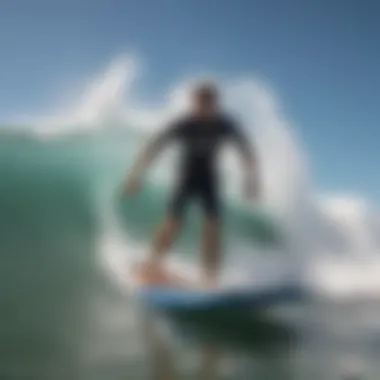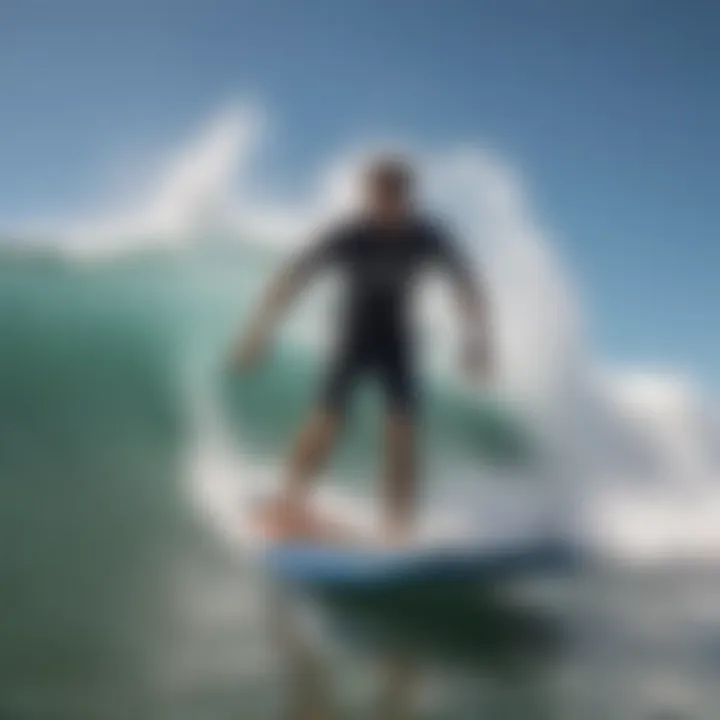Exploring the Versatility of the Boogie Board: A Deep Dive


Intro
The boogie board, much loved by surfers and beachgoers alike, is not simply a piece of foam. It's a portal to wave riding for a multitude of people. As you glide over the water’s surface, the thrill you experience is often connected to how you engage with your board. But what makes the boogie board such a versatile tool? This article fills that gap. We'll discuss techniques for various skill levels, the essential gear you need, and even the environmental aspects of this pastime. Let's hit the waves.
Surfboarding Techniques
Beginner Tips for Mastering the Basics
For those stepping onto their first boogie board, first things first: choose the right equipment. Generally, a thicker board is more buoyant, making it easier for novices to ride the waves. Here are some tips:
- Start on the Sand: Before you venture into the water, practice lying on your boogie board in a controlled environment. Get comfortable with how it feels.
- Positioning is Key: When you lie on the board, ensure your hips are about two-thirds of the way back. The ideal positioning allows for an efficient push-off into the wave.
- Paddle with Purpose: Using your hands, paddle toward the wave. Timing is crucial—start paddling just as you feel the wave begin to lift you.
- Ride the White Water: For beginners, riding the white caps is a great way to build confidence. It’s safer and offers instant gratification as you glide back to shore.
Once you gain confidence, you can explore more adventurous techniques.
Advanced Techniques for Seasoned Surfers
As you become more adept, it’s time to refine your skills:
- Cutbacks: This maneuver involves turning back toward the wave after riding it. It’s a great skill that allows you to maintain speed and control.
- Tube Riding: For those who feel they've mastered the basics, riding inside the curl of a wave can be an exhilarating experience. To achieve this, you’ll need to apply a combination of speed, balance, and timing.
- Tricks & Flips: Advanced riders might explore tricks like spins or flips. It's recommended to get pointers from experienced surfers or take a lesson to enhance your style safely.
"Mastery comes through practice; every wave is a lesson waiting to be learned."
Surfboard Equipment
Reviews of the Latest Surfboards on the Market
As the surf industry evolves, so does the technology behind boogie boards. Popular brands like BZ and Morey are constantly updating their designs. Here are key aspects to look for in a quality board:
- Material: High-density polyethylene or closed-cell foam tends to be durable and withstands the test of time.
- Size Choices: Depending on your weight and height, you’ll want to select a board that aligns with your body proportions.
- Tail Shape: A crescent tail offers more maneuverability, while a square tail provides stability—pick your poison based on your riding style.
Jumping into customer reviews on platforms like Reddit or Facebook can give insights into the performance of specific models.
Essential Gear for Every Surfboarder
Aside from the board itself, a few key accessories can elevate your boogie boarding experience:
- Leash: This keeps your board close, so you don’t have to swim back after every wipeout.
- Wetsuit: Depending on water temperature, a wetsuit can protect you from cold conditions and potential scratches.
- Wax: To improve grip, applying wax on the board enhances control, particularly in wet conditions.
Investing in quality gear ensures that you enjoy your surfing experience while emphasizing safety and performance.
In wrapping up this section about techniques and equipment, it’s clear that the allure of boogie boarding runs deeper than just fun. It's about understanding the interplay between you, your equipment, and the waves. In the following sections, we will dive into the cultural significance of boogie boarding, maintenance tips, and even explore eco-friendly trends shaping its future.
Preface to the Boogie Board
When it comes to experiencing the thrill of riding waves without the full-on commitment of surfing, the boogie board stands as a versatile companion. It’s not just a mere foam slab for fun; it’s a bridge connecting people to the ocean, offering a diverse range of opportunities for both seasoned surfers and those just dipping their toes into the salty waters. In this section, we’ll peel back the layers of the boogie board’s essence—looking at what it is and why it matters in the broader context of water sports.
Definition and Purpose
At its core, a boogie board is a buoyant, lightweight riding board that grants momentum and glides across the surface of waves. Typically made from materials such as foam or fiberglass, it provides stability and user-friendliness that appeals to a wide array of water enthusiasts. From toddlers who want to ride gentle waves close to shore, to seasoned surfers practicing their moves—this board adapts to various levels of ocean interaction.
The purpose of the boogie board extends beyond recreational use; it serves as a tool for education and skill development in water handling. Beach instructors often encourage newcomers to use boogie boards to learn the rhythm of the ocean before graduating to stand-up surfing. It’s an excellent way to build confidence, enhance agility, and familiarize oneself with wave patterns.
Historical Context
The roots of the boogie board can be traced back to the ancient Hawaiians, who referred to it as a “paipo” board, which they used for riding ocean swells. However, the modern evolution began in the 1970s when Tom Morey introduced what we now know as the boogie board to the surfing world. This innovative design not only changed the landscape of wave riding but also brought a bunch of folks into the ocean’s embrace who might otherwise have stayed on the shore.
Today, boogie boarding has evolved into a cultural phenomenon. From sun-soaked beaches in Southern California to the surf spots of Australia, it has carved its niche in the global water sport community. The accessibility and affordability of boogie boards have made them popular tools for families—enabling a variety of ocean experiences for all ages.
"Riding a wave on a boogie board is not just about the ride; it’s about connecting with nature and building memories on the water."


As we go deeper into this article, we will explore the intricate design of boogie boards, techniques to ride them effectively, and their cultural significance, culminating in an understanding of how this simple yet versatile tool continues to shape the experiences of wave riders around the world.
Design Characteristics of Boogie Boards
The design characteristics of boogie boards play a crucial role in their functionality, performance, and overall user experience. Understanding these aspects is essential for surfers and beach enthusiasts, as choosing the right board enhances riding abilities while ensuring safety. In essence, the selection of materials, shapes, sizes, and innovative features directly influences how one interacts with waves, making these characteristics significant for anyone eager to dive into the world of boogie boarding.
Materials Used
When it comes to materials, boogie boards have come a long way from their humble beginnings. Traditionally, these boards utilized materials like wood or foam, limiting their performance. Now, a variety of materials is available, each bringing its set of advantages.
- Polyethylene: This plastic material is lightweight and affordable, making it a common choice for beginners.
- EVA Foam: Known for its shock absorption and grip, this foam is often found in higher-end models, providing a more comfortable ride.
- EPS Foam: Like the materials used in surfboards, EPS foam is very buoyant and contributes to speed and maneuverability.
- Fiberglass: Many advanced boards incorporate fiberglass for added strength, helping them withstand the wear and tear of ocean waves.
The choice of material can dictate not just performance but also durability, affecting how long a board lasts before it needs replacing. A quality board made from premium materials often leads to a more enjoyable riding experience and greater confidence in the water.
Shapes and Sizes
Not all boogie boards are created equal; they come in a myriad of shapes and sizes, each designed for different riding styles and conditions. A rider’s skill level, age, and personal preference significantly influence the choice of size and shape.
- Length and Width: Longer boards typically offer better stability, which is beneficial for beginners. However, they may sacrifice maneuverability. Conversely, shorter boards are more agile, appealing to advanced riders.
- Shape: A rounded nose can help with paddling and stability, while a pointed nose allows for faster penetration through waves. Additionally, the tail shape can affect turning and control.
Ultimately, the right size and shape contribute to a tailored experience in the surf, providing the perfect balance between performance and comfort.
Innovations in Design
Over the years, boogie boards have witnessed innovations that enhance their design and functionality. With technology moving forward at breakneck speed, these changes have made boogie boarding more accessible to everyone from beginners to seasoned pros.
- Hydrodynamic Elements: Many modern boards now feature hydrodynamic designs, allowing them to cut through water with less resistance. These shapes help the rider hold speed and maneuver more effectively.
- Drop-through Decks: This design allows for a lower center of gravity, enriching stability and making it easier to balance while riding the waves.
- Printed Graphics and Customization: The aesthetics of boogie boards have not been neglected. Riders often seek boards that reflect their personal style, and many brands offer customizable graphics for this reason.
Innovations in boogie board design not only make riding more enjoyable but also encourage more people to experience the thrill of catching waves.
In summation, the design characteristics of boogie boards are fundamental in shaping the riding experience. Different materials, shapes, and innovative attributes cater to a wide range of users, emphasizing the importance of selecting the appropriate board for optimal performance. As people become more aware of these factors, it inevitably fosters a deeper appreciation for the versatility of the boogie board.
Techniques for Riding Boogie Boards
Understanding the techniques for riding on boogie boards is essential for anyone looking to not only enjoy the waves but to do so safely and effectively. Whether you're a fresh face at the beach or a seasoned surfer transitioning to this playful board, mastering these techniques opens up a world of fun and enhances your overall experience in the water.
The ability to ride a boogie board efficiently requires not only skill but also an appreciation for the dynamics of the ocean. From learning how to catch a wave at the right moment to executing precise maneuvers, the right techniques can elevate one’s enjoyment and help avoid mishaps both in and out of the surf.
Basic Riding Techniques
Now, diving into the simplest of techniques, getting the basics down is key for any novice. Here are some fundamental steps:
- Positioning Yourself: Lying flat on the board, make sure your body is centered. Your hips should be on the board’s midpoint, with your arms extended in front for balance.
- Catching the Wave: Start paddling with your arms just before the wave approaches. Timing is everything; the wave's energy propels you forward, so try to match its rhythm.
- Riding Technique: As the wave lifts your board, keep your body tight and steer with your hips to stay in line with the wave. This might feel unnatural initially but soon it will become second nature.
Once you’ve nailed the basics, it’s your passport to a world of exhilarating fun on the water.
Advanced Maneuvers
If you feel comfortable with the basics and want to take it to the next level, then advanced maneuvers could be just what you need to impress your friends and challenge your skills. Here are a couple of them:
- The Drop Knee: This technique involves dropping one knee onto the board while keeping the other foot planted. It allows for better control and turns in sharper waves.
- 360 Spins: While it may sound advanced, with practice, you can learn to pivot your board and spin in a full circle. This trick adds flair and showcases agility in the wave.
Each of these moves requires practice, but once you get the hang of them, they can transform your ride into something exhilarating.
Safety Considerations
While having fun is the name of the game, safety can never be overlooked. Engaging in boogie boarding comes with its share of risks, so it’s wise to consider a few safety measures before hitting the waves:
Always respect the ocean. Waves can be unpredictable, and conditions change rapidly.
- Wear a Leash: A leash keeps your board close to you and reduces the risk of it hitting someone else.
- Check the Weather and Surf Conditions: Knowing when it's safe to ride can make all the difference. Check for waves that are appropriate for your skill level.
- Be Aware of Others: When you're in the water, stay alert and avoid collisions with fellow surfers, swimmers, or any potential hazards.


Ultimately, combining the right techniques with sufficient safety precautions will not only improve your skills but also ensure that your boogie boarding experiences remain fun, safe, and memorable.
Cultural Significance of Boogie Boarding
The world of boogie boarding extends beyond the thrill of catching waves; it encapsulates a rich tapestry of culture, community, and shared experiences. In this section, we’ll unwrap the significance of boogie boarding within surf culture and its broader impact on local communities.
Boogie Boards in Surf Culture
Boogie boards have carved a niche for themselves within the larger realm of surf culture. While some may see boogie boarding as lesser than traditional surfing, it actually fosters a sense of inclusivity that transcends age and skill level. Enthusiasts are quick to point out that the joy of riding waves isn’t limited to standing on a surfboard.
In the surf community, boogie boarding is often seen as a gateway. Young riders, who might not yet possess the balance or strength to surf traditionally, can gain invaluable wave-riding experience on a boogie board. As they develop their skills, they may later transition to surfing, enriching the surf culture with fresh perspectives and diverse talents.
Additionally, boogie boarding brings together a varied demographic. Picture this: a sunny beach day where families, teenagers, and seasoned veterans mingle, sharing tips and laughter. Beach days transform into vibrant community events, highlighting camaraderie and fostering new friendships. This sense of belonging is monumental, as it encourages new generations to appreciate and embrace ocean activities.
"Boogie boarding is not just a sport, it's a rite of passage for many beach-goers and a tradition passed down through families."
Influence on Local Communities
Boogie boarding also leaves its mark on local communities, impacting economies and lifestyles alike. Many coastal towns depend on the influx of tourists drawn by the appeal of sun-soaked beaches and the lively vibe that comes with boogie boarding.
Local businesses, from surf shops to eateries, thrive due to the steady stream of beachgoers eager to partake in this frolicsome tradition. Here’s a look at the ways boogie boarding influences these communities:
- Economic Boost: Increased sales for local surf shops, rentals, and lessons.
- Community Spirit: Organizing competitions and events strengthens ties among residents and visitors.
- Cultural Heritage: As boogie boarding evolves, it integrates local traditions, storytelling, and practices, further enriching the cultural fabric.
In summary, the cultural significance of boogie boarding manifests not only in shared experiences among riders but also in economic growth and communal spirit. The waves are a common thread weaving diverse individuals and communities together, creating lasting memories and fostering a unique ocean-centric culture.
Environmental Considerations
In an age where the threats posed by climate change and pollution weigh heavily on our minds, examining the environmental aspects related to boogie boarding takes on heightened importance. Just as this thrilling activity connects us to the ocean waves, it also challenges us to reflect on our responsibility towards preserving the very waters we cherish. Addressing sustainability in the realm of boogie boarding ensures that future generations can revel in the same exhilarating experiences we enjoy today, while protecting the ecosystems that support them.
Sustainable Materials
When it comes to boogie boards, the choice of materials has a profound impact on the environment. Traditionally, many boogie boards have been constructed using polystyrene foam, which, although lightweight and buoyant, poses significant challenges regarding recyclability and biodegradability. However, recent shifts towards sustainable materials mark a positive evolution in this sport.
For example, manufacturers are increasingly turning to biodegradable materials such as expanded polyethylene (EPE) foam. This substance, due to its eco-friendly profile, offers similar performance characteristics while reducing long-term harm to the environment. Not only does this material provide similar buoyancy and durability, but it ultimately decomposes more easily, minimizing landfill contributions.
When considering a new boogie board, opting for brands that utilize sustainable practices can make a tangible difference. One such example is SCOUT, which has pioneered the use of plant-based materials in their products, providing eco-conscious riders options without sacrificing quality.
Minimizing Environmental Impact
Boogie boarding is not without its ecological footprint. Various actions taken by users can contribute, whether directly or indirectly, to the adverse effects seen on marine life and coastal areas. As riders, we have a crucial part in mitigating this impact. Here are a few ways to align our passion with environmental responsibility:
- Choose Eco-Friendly Gear: Beyond just the materials used in the board's construction, other components such as leashes and fins can also be selected based on their ecological impact.
- Practice Leave No Trace principles. This approach includes cleaning up after oneself by collecting waste left by others, ensuring beaches remain pristine for both marine life and fellow beachgoers.
- Advocate for Awareness in one's community. Engaging others about the importance of protecting fragile coastal ecosystems can amplify the collective impact, inspiring more sustainable behaviors.
"The seaside is our playground, let’s keep it clean for tomorrow's adventure seekers."
Boogie Boarding as a Family Activity
As families search for ways to bond and create lasting memories, boogie boarding emerges as a remarkable activity that caters to everyone, regardless of age. It’s not just about catching waves; it’s about shared experiences, laughter, and adventure. This section highlights why boogie boarding stands out as a fantastic family activity, focusing on its benefits for various ages and crucial safety considerations for young riders.
Benefits for All Ages
Boogie boarding can be as easy as pie or as challenging as one wants it to be. It allows everyone, from tiny tots to grandmas and grandpas, to participate. Here are a few notable benefits:
- Physical Fitness: Riding the waves involves paddling, balancing, and maneuvering which provides a good workout without feeling like a chore. It helps in building strength and stamina.
- Coordination and Balance: For the young ones, catching their first wave can significantly improve their balance and coordination. It sets a strong foundation for other physical activities.
- Social Skills: Engaging in this shared endeavor can bolster family bonds. It teaches kids the value of teamwork when they’re helping each other ride a wave, or exchanging techniques and tips.
- Stress Relief: The ocean has a calming effect. Spending a day on the beach can melt away stress, promoting overall well-being for the entire family.
Rather than being a mere leisurely pursuit, boogie boarding can transform into an exciting event that strengthens familial ties.
Safety for Young Riders
Safety should be the priority when heading out to catch waves, especially for younger riders. Here are important considerations to keep in mind:


- Age-Appropriate Boards: Choose a boogie board that suits your child's size and skill level. A smaller, lightweight board is easier for them to maneuver.
- Use of Proper Gear: Invest in rash guards or wetsuits to provide warmth and protect against rashes. Even for experienced kids, wearing a life jacket can create an added layer of safety.
- Supervised Riding: Always keep a watchful eye on younger children while they are in the water. Clear communication is vital—children should know to stay within a designated area.
- Understanding Water Conditions: Before heading out, familiarize yourself with the day's beach conditions. Choose a beach with gentle waves for beginners and ensure they understand basic water safety rules.
"Safety first! Whether you are catching waves or enjoying the beach, knowing how to protect young riders is essential for a great day out in the water."
By emphasizing the importance of safety, families can make sure their boogie boarding outings are enjoyable and risk-free.
The Role of Boogie Boards in Surf Training
In the world of surfing, mastering the art requires dedication, grit, and a knack for reading the sea. Enter the humble boogie board, a tool that provides numerous benefits for novice surfers and seasoned professionals alike. It serves not only as a fun beach accessory but plays a crucial role in surf training, facilitating skill development and honing various techniques.
Skill Development for Surfers
Boogie boarding is an excellent entry point for aspiring surfers. The dynamics of riding a wave on a boogie board can mirror the initial experiences and challenges encountered on a surfboard. Surfers learn key skills such as balance, wave selection, and timing—all of which are transferable to surfing.
- Wave Reading: Beginners often struggle to identify the right moment to catch a wave. On a boogie board, which is more forgiving, riders can practice observing wave patterns without the pressure of standing upright. Before they realize it, they're already training their instincts that will later translate onto a traditional surfboard.
- Body Positioning: Proper body alignment is essential when riding a wave. A boogie board allows surfers to experiment with different postures to find what works best for their style, which can significantly enhance their ability to ride a surfboard in the future.
- Paddling Technique: Paddling is a fundamental skill in surfing. While the paddling technique on a boogie board differs from that on a surfboard, it builds muscle strength and endurance. Surfers can practice faster paddling motions without the intimidation factor of balancing on a larger board.
"Boogie boards pave the way for surfers, allowing them to ease into the sport, build confidence, and cultivate essential skills."
Coaching Techniques
For coaches, utilizing boogie boards as part of their training regimen offers an array of opportunities to develop more effective teaching strategies. Here are several methods that can enhance training sessions:
- Progressive Learning: Coaches can structure a series of drills that start with basic boogie board riding and gradually progress to standing on surfboards. This incremental learning reduces anxiety for new surfers and builds their confidence step by step.
- Video Analysis: Incorporating technology can play a pivotal role in skill acquisition. Coaches can film sessions, allowing students to glean insights by watching their technique on both boogie boards and surfboards. This visual feedback can lead to rapid improvement.
- Team Training: Boogie boards encourage a sense of camaraderie. Group sessions can foster motivation and competition in a non-pressuring environment. This is particularly beneficial for younger surfers who thrive off social interactions and teamwork.
Utilizing boogie boards is not just about having fun in the waves; it’s about laying the groundwork for surf mastery. This versatile tool is integral not only for beginners but also as a valuable resource for coaches shaping the next generation of surfers.
Travel and Boogie Boarding Destinations
When planning a boogie boarding adventure, choosing the right destination is almost as important as selecting the perfect board. Not every wave is created equal, and the atmosphere of the location plays a crucial role in shaping the experience. From scenic coastlines to vibrant beach communities, each spot offers unique attributes that cater specifically to both seasoned riders and those just starting out. Furthermore, understanding the local culture and regulations can greatly enhance the trip while ensuring safety and enjoyment for everyone involved.
Top Locations for Boogie Boarding
Some beaches stand out as exceptional spots for this exhilarating water sport. Here's a roundup of notable locations:
- Huntington Beach, California: Often called "Surf City, USA," this place has consistent waves and a lively beach culture. The warm water and soft sand make it a favorite for families as well.
- Waimea Bay, Hawaii: Known for its powerful waves, Waimea Bay welcomes experienced boogie boarders looking for thrilling challenges during the winter months. The scenery is breathtaking, with lush greenery surrounding the beach.
- Gnaraloo, Australia: This remote surfing paradise boasts some of the best boogie boarding conditions, with long, peeling waves that are perfect for both performance and leisure.
- Baja California, Mexico: The warm sun and the enthusiastic local surfing community create an inviting environment. The beaches here are often less crowded, which is ideal for those seeking a more laid-back experience.
- Bondi Beach, Australia: This iconic spot is not just famous for its surf culture but also for its vibrant community and activities. Beginners will appreciate the surf schools available, offering lessons specifically tailored for boogie boarding.
Consideration of the season is just as vital. Waves can significantly fluctuate based on the time of year, so keep an eye on local surf forecasts before making a trip. Visiting popular spots during off-peak times can lead to a more enjoyable experience, free from the hustle and bustle that busy seasons often bring.
Preparing for a Boogie Boarding Trip
Preparation is key to ensuring a pleasant and safe experience while boogie boarding. Here are essential considerations:
- Check Gear: Before heading out, make sure your boogie board and other equipment like fins and wax are in good shape. A board with the right buoyancy and size can greatly improve your time in the water.
- Research the Location: Familiarize yourself with the beach's conditions, including wave patterns and tides. Understanding the local environment can prevent accidents and enhance your overall experience.
- Bring Essentials: Sunscreen, water, and a first aid kit are must-haves. Hydration is often overlooked, so keep water handy to stay refreshed under the sun.
- Educate Yourself on Safety Guidelines: Knowing the rules of the beach, such as where it is safe to ride, can help avoid dangerous situations. Awareness of other surfers and swimmers will contribute to a safe adventure.
- Plan for Weather: Check the weather forecast to avoid stormy days that can complicate riding conditions. Calm, clear days are usually best for any water activities.
By adequately preparing, you not only ensure safety but also guarantee a more fulfilling experience on the waves. The joy of riding these natural forces amid picturesque settings can be a defining moment for any adventurer.
The Future of Boogie Boarding
The future of boogie boarding is an engaging topic, reflecting emerging trends, advancements in technology, and shifting cultural attitudes. As the waves of change sweep across the surfing community, boogie boarding, often seen merely as a fun beach activity, is setting its sights on becoming a more integral part of ocean sports. The importance of this evolution cannot be overstated; it can lead to improved safety standards, enhanced thrill experiences, and broader inclusivity for enthusiasts of all skill levels. Looking forward, the boogie board is not just a piece of foam that grants access to the sea; it is evolving into a symbol of versatility and innovation.
Emerging Trends
As we move deeper into the 21st century, several trends merit attention. One notable trend is the growing embrace of eco-conscious practices within the boogie boarding community. More manufacturers are gravitating towards sustainable materials, often aiming for biodegradable or recyclable options. This shift not only addresses the urgent need for environmental responsibility but also taps into consumers' desire for products that cause less harm to our precious oceans.
Another notable trend is the increase in awareness of inclusivity within the sport. Boogie boarding is becoming more accessible to individuals with disabilities. Innovations like specialized boards with adaptive features are making it possible for everyone to enjoy the waves. This expansion of the sport encourages diversity and creates a welcoming atmosphere at beaches across the globe.
"As more people recognize the joy of the ocean, it promotes not only individual enjoyment but also collective responsibility towards marine conservation."
Technological Advancements
The technological advancements in the world of boogie boarding are nothing short of remarkable. Boards are being developed with cutting-edge materials that enhance buoyancy, speed, and durability. For instance, some manufacturers are experimenting with lighter materials to reduce strain while paddling out to catch the next wave. This makes it more enjoyable, especially during long sessions.
Moreover, certain brands are integrating smart technology into boogie boards. Features like built-in GPS tracking and wave sensors are increasingly common, providing users real-time data on wave conditions and their performance. These innovations not only elevate the experience but also facilitate better training routines for aspiring boogie boarders.
The future also holds potential for the virtual realm, with augmented reality apps that collaborate with boogie boards to provide tutorials and feedback on riding techniques. Imagine getting instant feedback on your form through your smartphone while enjoying the thrill of catching a wave!
As we stand on the brink of this exciting future, it's clear that the boogie board's evolution offers much more than just a fun day at the beach. The emphasis on sustainability, inclusivity, and technological enhancement tallies with the ongoing desire for innovation in the world of water sports.















